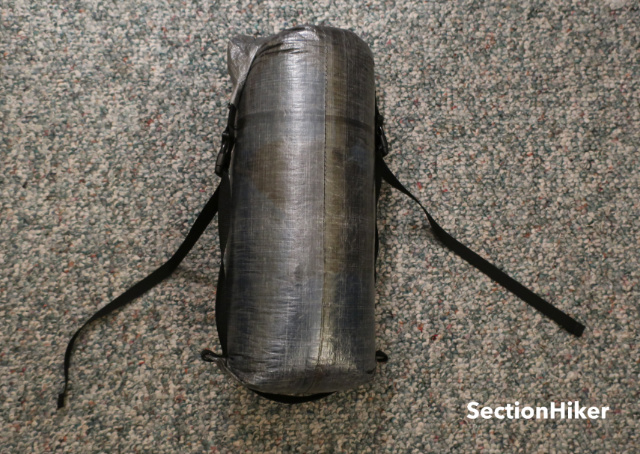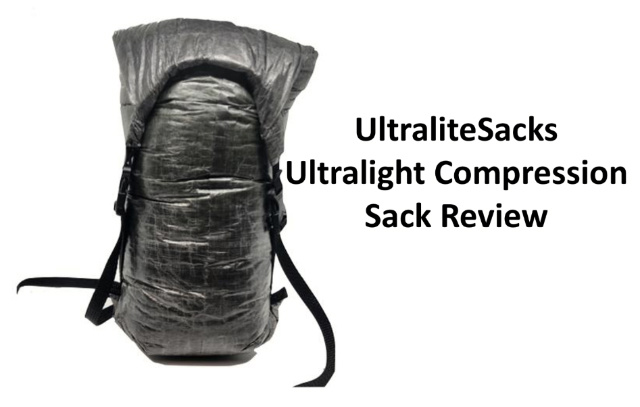UltraliteSack’s Ultralight Compression Sack is a roll-top compression sack made with Dyneema Composite Fabrics (DCF). It’s available in three volumes: small (5.5L), medium (6.8L), and large (9.5L). I’ve been eyeing the product photo that Garage Grown Gear had for it on their website and wondering if it works, whether it has any value, and why no one else has copied it yet. So I bought a medium-size one to satisfy my curiosity and try it out. The medium size is good for carrying quilts or warmer weather sleeping bags.
Specs at a Glance
- Product: Medium, black DCF compression sack
- Weight: 1.5 oz/ 44 grams (actual)
- Dimensions: 8.5″ x 22″ (actual)
Design

This DCF Compression sack is basically a roll-top stuff sack with two adjustable webbing straps that connect the ends of the roll-top closure to the base of the stuff sack. The construction is similar to the Lanshan roll-top stuff sacks that come with the tents the 3F UL and others sell.
Close inspection of the sewing reveals a neat little trick for anchoring the webbing straps at the bottom of the stuff sack without perforating the stuff sack interior with a lot of needle holes. The bottom corners of the stuff sack have extra feet to which the webbing straps are sewn. The extra feet are the bottom corners of two pieces of rectangular fabric sewn together to make a tube. Rather than cutting off the corners to make a rounded bottom, they sew a seam where the cut would have been made so that the inside of the stuff sack is rounded, but the webbing can still be sewn to the remaining corner. They also only use one continuous webbing strap, providing a “handle” at the base of the bag that you can grab while eliminating waste.

Usage
Once you stuff your item into the sack, you can fold/roll down the roll-top and engage the webbing straps to compress the item. While the stuff sack is seam-taped on the inside, there are enough exposed needle holes along the top of the roll-top that extra air can escape.
The medium stuff sack I purchased is quite narrow (8.5″ wide, measured flat), so you have to work to get an item like a down top quilt or a synthetic sleeping bag into it. But at 6.8L, it was the right size for carrying a 20-degree 800 fill power top quilt or the 40-degree synthetic-insulated mummy sleeping bag that I tested the compression sack with.
Size Reduction With and Without Compression
I’m sure many of us have compressed big sleeping bags with compression sacks to reduce the volume they take up in a backpack. So I was a little surprised at how little extra space was gained by performing that process was on a 20 degree, 800 fill-power down top quilt and a synthetic mummy sleeping bag.
When I manually stuff a top quilt or sleeping bag, I’m not really pushing that hard: I just stuff it in the bag and roll the top a few times as I would do with any roll-top stuff sack. When I engage the compression straps, that’s when I really crank down on them. I repeated this process multiple times and the size of the stuff sack measures as follows:
Down Top Quilt:
- manually stuffed: 13″ x 5.25″ x 6″ (l x w x h) = 409.5 cubic inches
- with compression: 12″ x 5.25″ x 6″ (l x w x h) = 378 cubic inches
Synthetic Insulated Sleeping Bag:
- manually stuffed: 16″ x 5.25″ x 6″ (l x w x h) = 504 cubic inches
- with compression: 15″ x 5.25″ x 6″ (l x w x h) = 472.5 cubic inches
This shows that there is only 1″ of length saved by applying the compression straps to the stuff sack, which is surprising. While compression straps are nice to have, I actually think that the real value of this product lies in its dimensions, narrow shape, and the fact that is made with a no-stretch product lie DCF.

To illustrate, compare the dimensions of the same 20-degree, 800 fill power down top quilt and synthetic sleeping bag as before when they are is stuffed into the UltraliteSacks (med) Ultralight Compression Sack and a Sea-to-Summit (8L) Ultra-Sil Dry Sack, which weighs 1.1 oz.
Down Top Quilt (manually stuffed):
- UltraliteSacks (med) Ultralight Compression Sack: 13″ x 5.25″ x 6″ (l x w x h) = 409.5 cubic inches
- Sea-to-Summit (8L) Ultra-Sil Dry Sack: 9.25″ x 7.25″ x 7.25″ (l x w x h) = 486.2 cubic inches
Synthetic Insulated Sleeping Bag (manually stuffed)
- UltraliteSacks (med) Ultralight Compression Sack: 16″ x 5.25″ x 6″ (l x w x h) = 504 cubic inches
- Sea-to-Summit (8L) Ultra-Sil Dry Sack: 12″ x 7.25″ x 7.25″ (l x w x h) = 630.75 cubic inches
The reason there is a difference in the volume used by the quilt and the sleeping bag in these two stuff sacks is that manual stuffing delivers better compression in the more constricted space of the DCF stuff sack. For instance, when you first start manually stuffing the DCF stuff sack, the air in the quilt or sleeping bag is immediately pressed out. Whereas in the wider Sea-to-Summit stuff sack, the initial part of the quilt/sleeping bag you stuff can retain more of its trapped air.
Put another way, the density of insulation is higher and more uniform through the whole length of the DCF stuff sack than the Sea-to-Summit stuff sack, where the density is probably highest at the top of the bag. This also explains why the compression straps have such a small incremental effect on the DCF stuff sack volume when applied to a manually stuffed item.
Recommendation
The medium-size UltralightSacks Ultralight Compression Sack is a Dyneema (DCF) roll-top compression sack with a thin tubular shape that is narrower than most other stuff sacks designed for storing quilts and sleep bags. While using it will decrease the volume required to pack a top quilt or sleeping bag, it’s the shape and size of this particular stuff sack and the no-stretch material it’s made with that provides the true value of the product. The compression straps are just along for the ride.
However, UltraliteSacks makes a 27 gram, regular, medium-tall rolltop DCF stuff sack (approx 6.8L) that’s 21.5″ x 9″ which is very close in size to the compression sack reviewed here but without the extra webbing compression straps, if you want something lighter and simpler that provides pretty much the same bang for the buck. Check out their other products too. They make an insulated DCF cooler stuff sack that looks pretty interesting (good for carrying frozen steaks or brews) and some nice multi-stuff sack “kits” that would make good holiday presents.
Disclosure: The author purchased this product.
SectionHiker is reader-supported. We only make money if you purchase a product through our affiliate links. Help us continue to test and write unsponsored and independent gear reviews, beginner FAQs, and free hiking guides. SectionHiker.com Backpacking Gear Reviews and FAQs
SectionHiker.com Backpacking Gear Reviews and FAQs 
Wow, just wow. You geeked out on this analysis! But the implications are staggering. I’d be surprised if more companies didn’t start making narrow DCF dry sacks.
The DCF is nice because it’s so lightweight, but the Ultra-Sil also doesn’t stretch beyond a certain point. I think ultimately it’s the shape and size that matter most.
I added a similar thing to an existing DCF stuff sack I had. I just added a patch of some spare DCF material on the bottom with two strips of that DCF tape they use (It forms an external tube on the outside of the bottom to run a strap). I just did it for grins and giggles. My quilt was “tight” in the bag so the strap can serve to keep the roll top from wanting to pop open. In the end, it works with or without the strap. But it was easy to try and if I get tired of the strap I just slip it off. I would not go to the trouble unless you happen to have some unused DCF material/tape around
I’m really happy with my UtraliteSacks ditty bags. Sounds like the high quality is also apparent in their stuff sack ?
The quality is there, but I’m not sure that the point of the product is.
Phil,
I have a UGQ quilt that is a long extra wide, I love it and it’s very light but it is too much fabric to just stuff in my pack , would you recommend the large size in this stuff sack to compress and hold my quilt because it is so bulky??
If it’s a 20 degree quilt or colder, it probably won’t fit into the medium. I used an 800 fp wide regular HG quilt for my compression testing and it was just the right size.
Thanks, might try a large , should do the trick..
You don’t have to convince UltraLiteSacks of anything, they do sell 6 different regular roll top dry bags in very similar sizes without compression straps on their website. I’m assuming you only looked at GGG? I’ve been using their stuff for years now and love it but you gotta go to their website for the most variety in products, colors, or sizes.
Don’t assume. I did look at their website, but nothing popped out at me. I plan to look again and I have an active and quite cordial correspondence with the owner/founder.
Philip, thanks, and I’m planning on checking this product out, as am very happy with HMG’s stuff sacks and pods. I’m just curious on your experience with one thing you mentioned: I’ve heard that it’s not a good idea to
” compress” down sleeping bags, as continuing to do so, reduces the loft and thus, less warmth. Obviously, with synthetic bags, it’s not an issue. I’ve always tried to maintain the highest loft by hanging my bags and not stuffing and compressing them too much, and never with a compression sack. Any thoughts? Thanks!
You absolutely can compress a down quilt/sleeping bag. It really doesn’t matter that much if you use a compression sack or not. The issue you raise has to do with storage. Don’t leave a down bag compressed when you store it. The same holds for a synthetic insulated bags. Yes, synthetic insulation is also susceptible to compression. The reason down is valued more highly, besides a higher warmth to weight ratio is that it is more resilient to compression over the long term than synthetic insulation, which breaks down faster. It other words down stays loftier longer.